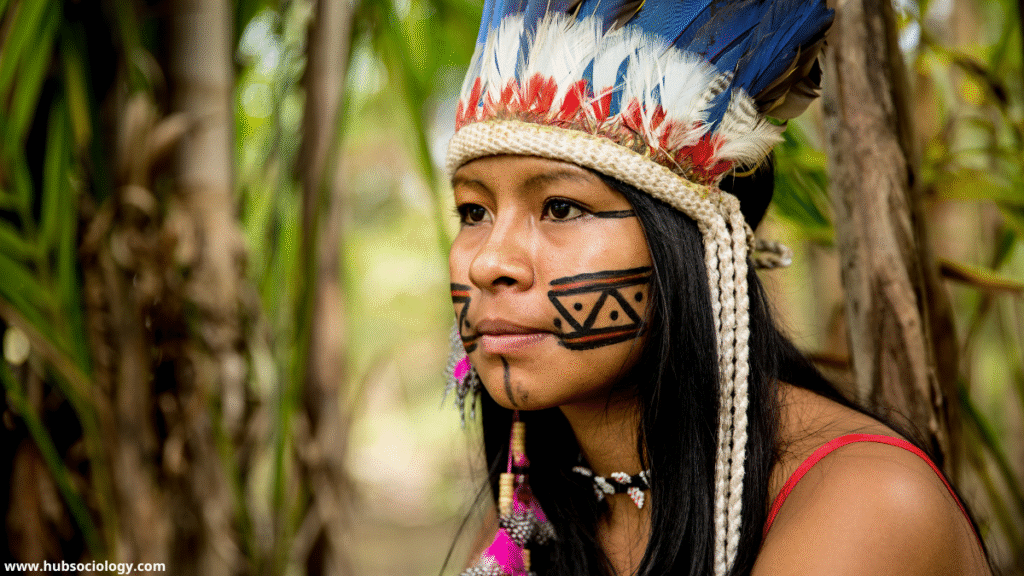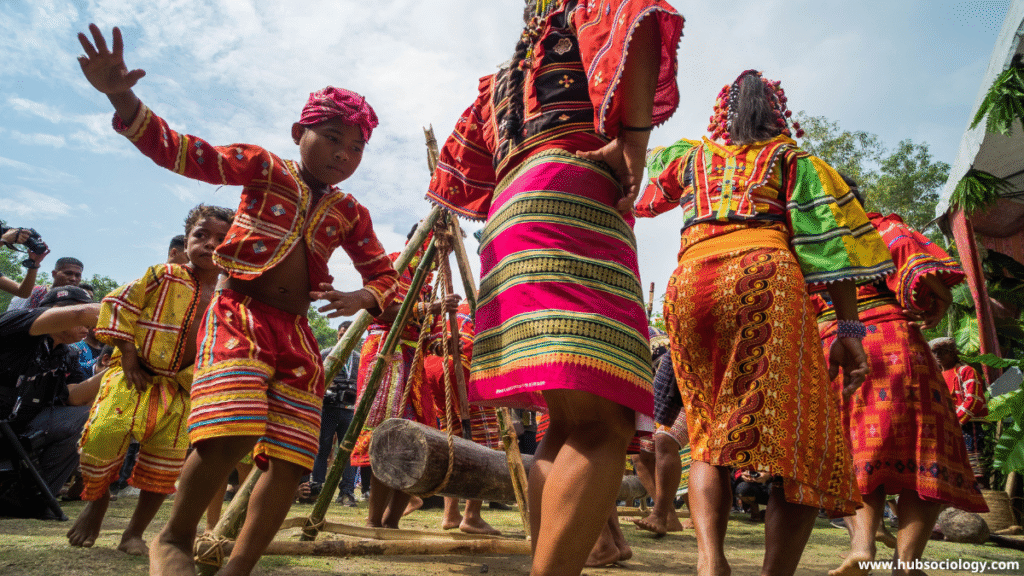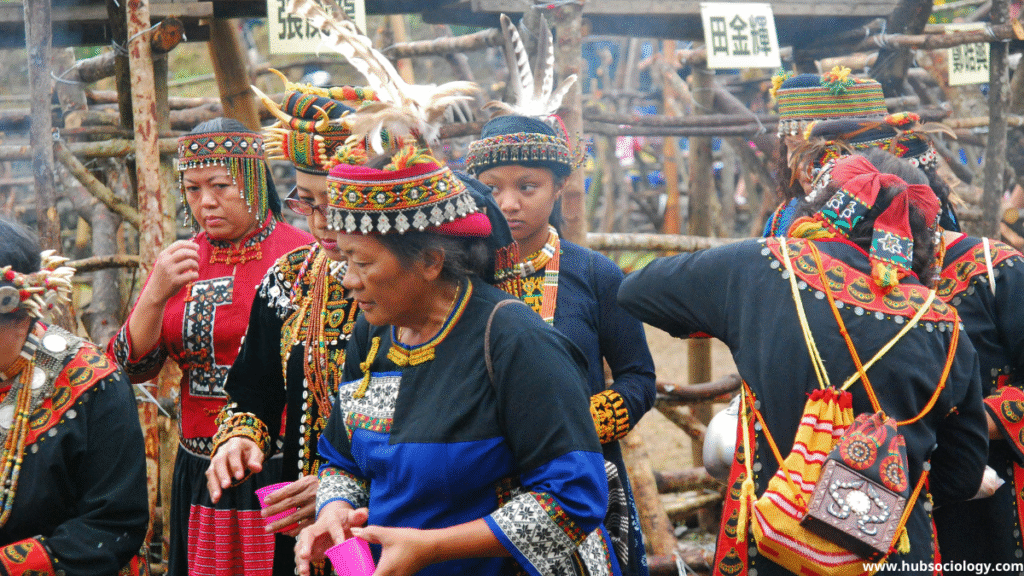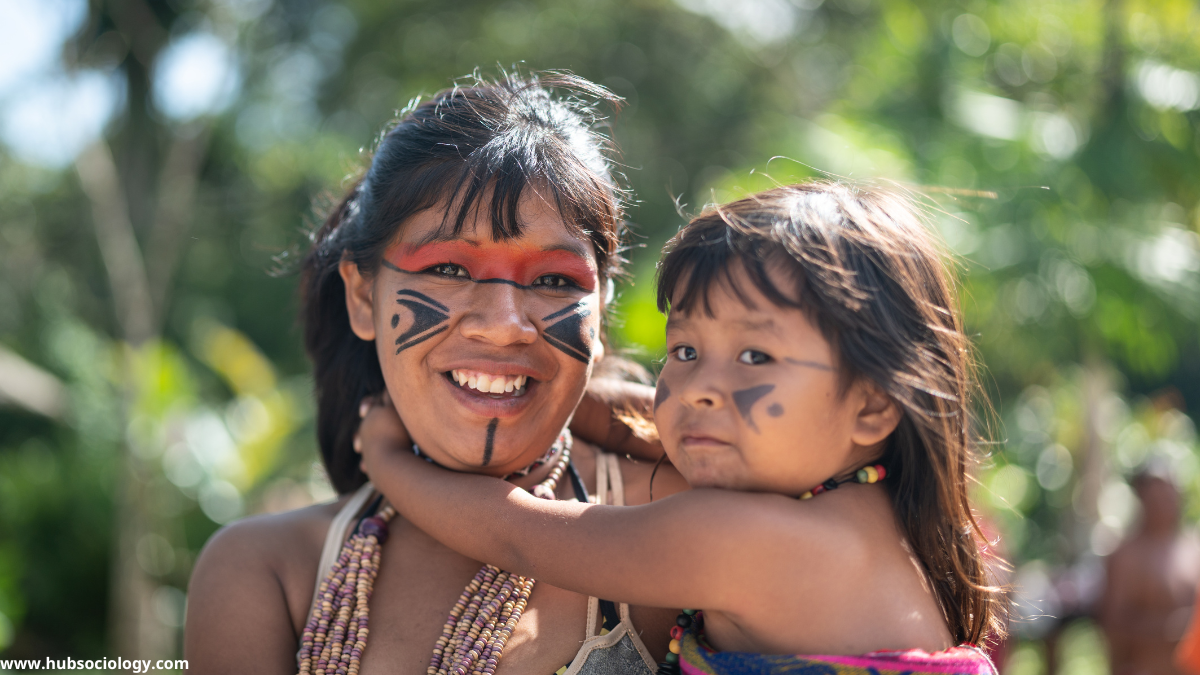Introduction on Tribal Social Stratification
Social stratification, in its simplest sense, refers to the hierarchical arrangement of individuals or groups in society based on various socio-economic, cultural, or political criteria. While stratification is often associated with large, complex societies—through class, caste, race, or status divisions—it is equally relevant in the study of tribal communities. Tribal societies, often considered “simple” or “primitive” in anthropological discourse, also exhibit forms of differentiation, ranking, and inequality, though their bases and structures differ from those of mainstream societies.
The sociological study of tribal social stratification helps us understand how power, prestige, and resources are distributed within small-scale communities. It highlights the interplay of kinship, economy, politics, gender, and cultural practices in shaping the internal hierarchy of tribes.

Defining Tribal Society
Tribes are usually defined as relatively small, homogeneous, and self-sufficient groups, bound by ties of kinship, territory, and shared cultural traditions. They often live in close contact with nature and practice subsistence economies such as hunting, gathering, pastoralism, or shifting cultivation. However, modernization, state policies, and integration into national economies have significantly altered tribal ways of life, thereby reshaping their internal stratification systems.
Unlike stratification in caste or class-based societies, tribal stratification is often less rigid and more closely tied to kinship and age structures. Yet, tribes are far from egalitarian; they display nuanced forms of hierarchy, authority, and exclusion.
Bases of Tribal Social Stratification
- Kinship and Lineage
- Kinship forms the backbone of tribal life and stratification. Many tribes are organized into clans, lineages, or moieties, which serve as the primary units of identity and belonging.
- Stratification may emerge between clans, with some enjoying ritual or political superiority over others. For example, in certain Indian tribes, particular clans hold priestly authority, while others specialize in economic roles.
- Kinship also determines marriage alliances, inheritance rights, and social prestige, thereby reinforcing hierarchies.
- Age and Gender
- Age plays a crucial role in tribal stratification. Elders are often revered as custodians of tradition, decision-makers in councils, and mediators in conflicts. Younger members must pass through initiation rituals to earn full adult status.
- Gender stratification is also visible. While many tribes allow women significant participation in economic and cultural life, patriarchal tendencies are widespread. Men often dominate political authority, land ownership, and ritual roles, although exceptions exist in matrilineal or matrilocal tribes (e.g., Khasi of Meghalaya).
- Economic Differentiation
- Traditionally, tribal societies are portrayed as egalitarian due to subsistence-level economies. However, inequality arises from differential access to land, forest resources, livestock, or trade opportunities.
- In tribes that practice agriculture or animal husbandry, wealthier families accumulate more resources, thereby gaining prestige and influence. The introduction of market economy, money, and wage labor has further intensified economic stratification in modern times.
- Political Authority and Power
- Tribes often practice systems of chieftainship, councils of elders, or village assemblies. Stratification emerges through the distribution of power, as chiefs or council leaders command respect and control communal resources.
- Hereditary leadership, as seen in some tribes, institutionalizes inequality by reserving authority for certain families or clans.
- Ritual and Religious Roles
- Ritual hierarchy is a significant dimension of stratification. Shamans, priests, or ritual specialists often occupy high status due to their perceived spiritual power and role in maintaining social order.
- Ritual purity and pollution, while not as elaborately codified as in caste systems, sometimes create symbolic boundaries within tribes.
Patterns of Stratification in Tribal Societies

- Segmentary Stratification
Many tribes follow segmentary lineage systems, where society is divided into clans or sub-clans with internal ranking. Prestige and influence flow from seniority of lineage or ritual superiority. - Egalitarian but Functional Differentiation
Some tribes emphasize collective decision-making and resource sharing. However, differentiation exists in terms of roles—such as hunters, warriors, or ritual specialists—leading to functional stratification rather than rigid hierarchy. - Stratification through Acculturation and Integration
Contact with mainstream society often introduces caste-like stratification in tribes. For instance, some tribes in central India have adopted caste practices such as endogamy, ritual taboos, and hierarchical clan divisions. - Gender-Based Stratification
In patriarchal tribal systems, women’s status is often secondary, restricted to household duties and agricultural labor. Yet in matrilineal tribes (e.g., Garos and Khasis), women enjoy inheritance rights and social influence, though political authority may still lie with men.
Tribal Stratification in India
India’s vast tribal population—spread across central, northeastern, and southern regions—offers diverse examples of stratification.
- Among Gonds and Oraons, stratification occurs between clans and through hereditary priestly roles.
- The Nagas follow village councils where elders and warriors hold higher status.
- In matrilineal tribes like the Khasi and Garo, property passes through women, but decision-making often rests with men.
- With economic change, many tribes now show class-like differentiation between landowners, wage laborers, and traders.
Additionally, integration into Hindu society has led to “Sanskritization” of many tribes, where they adopt caste practices and hierarchies, blurring the distinction between tribal and caste stratification.
Impact of Modernization on Tribal Social Stratification
Modern forces such as state intervention, education, industrialization, and migration have deeply reshaped tribal stratification.
- Economic Stratification: Wage labor, cash crops, and market participation have created sharp divides between rich and poor within tribes.
- Political Stratification: Reservation policies and political mobilization have elevated some tribal leaders to positions of regional or national influence, while many remain marginalized.
- Cultural Stratification: Exposure to mainstream religions and cultures has altered traditional rituals and authority, sometimes diminishing the power of shamans or clan elders.
- Gender Shifts: Education and employment opportunities have challenged patriarchal structures in some tribes, empowering women with new roles.
Thus, while stratification was once primarily kinship-based, it is now increasingly shaped by economic and political processes.
Sociological Perspectives on Tribal Social Stratification
- Functionalist View
From a functionalist perspective, stratification in tribal societies serves the purpose of maintaining order and stability. Role differentiation (warriors, elders, priests) ensures survival and cultural continuity. - Conflict Perspective
Conflict theorists argue that stratification reflects unequal access to resources and power, even within seemingly egalitarian tribes. The introduction of capitalism intensifies class divisions, exploiting weaker sections. - Interactionist Perspective
Symbolic interactionists highlight how everyday interactions—such as rituals, marriage negotiations, and kinship exchanges—create and reinforce hierarchies in tribal life.
Conclusion on Tribal Social Stratification
Tribal social stratification, though less rigid and formalized than caste or class, reveals important insights into how human societies organize inequality. Rooted in kinship, age, gender, economy, and ritual, tribal hierarchies reflect both traditional values and responses to modern transformations. Far from being static, tribal stratification is dynamic, constantly reshaped by external forces of state policies, market integration, and cultural exchange.

Studying tribal stratification from a sociological lens underscores the diversity of social structures beyond mainstream society. It challenges the myth of tribes as purely egalitarian communities and shows that even in small-scale societies, inequality is a pervasive social fact.
Do you like this this Article ? You Can follow as on :-
Facebook – https://www.facebook.com/hubsociology
Whatsapp Channel – https://whatsapp.com/channel/0029Vb6D8vGKWEKpJpu5QP0O
Gmail – hubsociology@gmail.com
Exam-style questions on Tribal Social Stratification
5 Marks Questions on Tribal Social Stratification
- Define tribal social stratification.
- Mention any two bases of stratification in tribal societies.
- How does kinship influence stratification among tribes?
- Give examples of gender-based stratification in Indian tribes.
- What role do ritual specialists play in tribal hierarchy?
10 Marks Questions on Tribal Social Stratification
- Explain the role of age and gender in tribal social stratification.
- Discuss the economic basis of stratification in tribal communities with suitable examples.
- How does political authority create stratification in tribal societies?
- Compare egalitarian and hierarchical patterns of stratification in tribes.
- Examine the impact of modernization on tribal social stratification in India.
15 Marks Questions on Tribal Social Stratification
- Discuss the major bases of tribal social stratification from a sociological perspective.
- Analyze the changes in tribal stratification due to integration with mainstream society.
- Critically examine gender roles in tribal stratification with examples from Indian tribes.
- Evaluate tribal stratification using functionalist, conflict, and interactionist perspectives.
- “Tribal societies are not purely egalitarian, but stratified in multiple dimensions.” Discuss.
